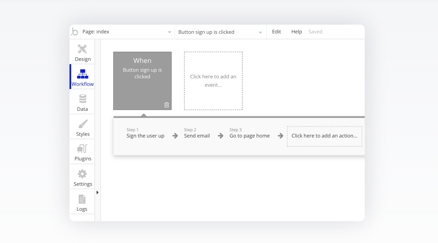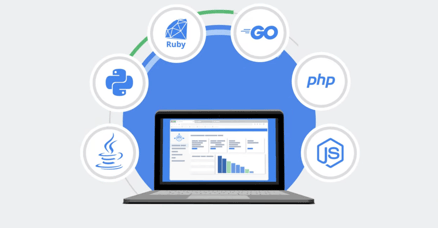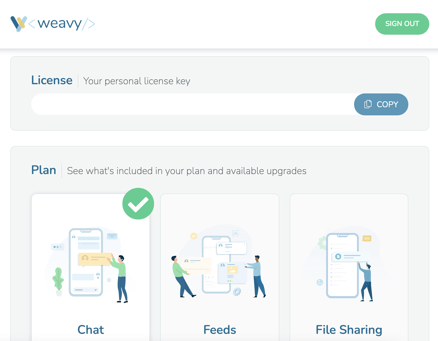As you may have noticed, we here at Weavy are big fans of low-code. To recap: low-code is a form of software development that is marked requiring a low amount of coding. Most low-code solutions present developers with a graphical user interface that enables them to edit properties and customize the final product, with these parameters set the solution generates the required code or even can roll out an entire application. We’re not alone in our love for low-code, Gartner estimates that within the next two years low-code tools will account for 65% of application development.

The rapid development of low-code tools and platforms have put developers and product managers in an ideal position to supercharge their app development, as low-code solutions now exist for nearly every stage of app development. Here are 4 tools to start your low-code journey and take you across every stage of app development.
1. Caspio - build a prototype
With apologies to Frank Zappa, the term “one size fits all” has largely proven to be little more than marketing jiggery-pokery. Whether it’s baseball caps or enterprise apps, there is rarely a solution that fits all use-cases. For companies that don’t want to take the time to bend popular CRMs like Salesforce or Hubspot to their will, or need a bespoke way to manage HR there’s Caspio.

Caspio is a low-code app development platform that comes with a number of quick start templates, meaning getting a functional CRM or data management tool is quick, easy, and cost-effective. They operate on a tiered model that ranges from a generous Free plan to a white-label Corporate plan. Each tier offers unlimited users and unlimited usage, making it eminently scalable. Caspio also offers free localization with 11 languages built-in, meaning your Caspio app can be deployed around the world with little additional effort.
Caspio is designed first and foremost for developing internal enterprise apps, but Caspio’s corporate tier gives you access to all of the important quality of life features you need for a white label app: SSO, account security, and guaranteed uptime. It’s easy to see why Caspio has become a favorite for several large businesses. If your goal is to release a SaaS app, Caspio is a great way to prototype and test functionality internally.
2. Bubble - build a SaaS app
You’ve validated your prototype, but now you want something you can release on the open market. If your goal is to make a consumer-facing app that works great on web and mobile, Bubble is designed to carry you from startup to unicorn. Bubble is a drag and drop application editor that lets you build a safe, responsive and user friendly web app with deep options for customization. New users can start from scratch or begin with one of Bubble’s premade templates.

Bubble is competitively priced at several tiers. Every price tier of Bubble gives full access to the application editor, includes dedicated hosting as well as a fully managed backend database and workflow system. Bubble also allows you to publish custom APIs that can hook your app's functionality into other apps and services. Every paid tier allows your app to be completely white-label and free of Bubble’s branding, and the highest tier allows you to deploy your app on your own AWS instance.
With a large library of Bubble and community created plugins, apps built in Bubble are heavily extensible with third party integrations, including popular SaaS payment processors like Stripe. Bubble also allows your app to be fully OAuth compatible right out of the box, meaning end-users can create accounts using their Google, Meta, or any other OAuth partner authenticators.
So you’ve got your app, now it’s time to release it into the world. If it seems daunting, that’s because it is. Even some of the most seasoned python pathfinders, javascript jockeys, and angular acrobats can find themselves baffled by the intricacies of modern cloud app deployment. For those wizards of web application development, Google has created a tool that demystifies deployment, scaling, and maintenance.

Google App Engine allows developers to upload their app source code to the cloud and let Google automate the deployment. App Engine is a fully managed hosting service that supports all the most popular development frameworks web app developers use today. In addition to providing an easy to use UI for managing your hosting set up, App Engine automatically scales and load balances your app based on real time demands. What that means is that you never have to worry about a high influx of users bringing down your app.
On the maintenance side, App Engine allows you to quickly and seamlessly push out new versions of your app without removing access to previous versions, meaning you can do soft launches of major updates, or focus test new features before they go live to all users. For product managers eager to get comparative data, App Engine also allows you to do automated A/B testing, so you can see in real time how new changes to the app affect usage.
4. Weavy - add new functionality
You’ve got your app up and running, you’ve got hosting handled and humming along, which means now it’s time to consider how you can make it better. One of the best low-code solutions to extending functionality is APIs. APIs provide a path to incredibly deep functionality with very little development investment. When it comes to adding collaboration functionality quickly and affordably, one of the best options available is Weavy.
Weavy is an API and SDK that allows developers to integrate collaboration features like in-app chat, in-app feeds, and in-app files in an incredibly small amount of time. Weavy allows developers to use in-app chat completely free, all you have to do is sign up for an account so you can be issued a license key. In-app chat comes with several third party integrations for file sharing services like Google Drive, Dropbox, or Box, and video calling services like Zoom and Microsoft Teams.
To expand functionality further, Weavy’s paid tiers give access to Feeds and In-app File management. With feeds you can create a news feed with threaded conversations, allowing for a more social network like experience. With In-app Files API you’re able to transform your app into the central repository for all of your users’ files across the internet, syncing with all major file storage services and allowing for local documents to be uploaded. Taken together these features can supercharge your engagement with minimal coding work.
Low-code tools have matured to a place where the barrier to entry for app developers is time and their own initiative. The opportunities for experimentation, iteration, and advancement are now endless. So whether you need to add new features, make your app cloud ready, or are starting from scratch you have the tools to turn your best ideas into the next great product.